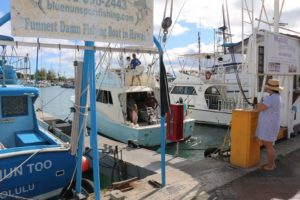
Charter boat clients are included in the new law, which took effect immediately upon signing. However, the bill requires the DLNR Division of Aquatic Resources (DAR) to first adopt a corresponding administrative rule and to develop a licensing system. This process could take close to a year to complete.
According to DAR administrator Brian Neilson, the bill was a component of an administrative package submitted to the 2021 legislature by DLNR. Neilson noted, “Marine fishing opportunities attract thousands of visitors each year, including tournament professionals. Visitors will gladly pay to fish premier fisheries and support fisheries management in Hawai‘i.”
Most states require fishing licenses, so getting a license should prove routine for most fishers.
Revenues generated by license sales will help support fishing opportunities and provide state-matching funds for the Federal Sport Fish Restoration Program. By law, revenues will be put into a special fund that can only be used for sport fish management. Recreational fishing license revenues must, by law, be deposited into a special fund, and may be used only for sport fish management. DAR has a number of continuing sport fish restoration projects, including fish aggregating devices (FADs), artificial reefs, fish stocking, and others which benefit recreational fishers.
Out-of-state fishing license fees:
- One-day license $20
- Seven-day license $40
- Annual license $70
- No license needed for children 15 and younger
- No license needed for active military, spouses, and children
DLNR has the option of increasing fees, but not more than once every five years, and increases must be tied to the consumer price index. It’s estimated once up and running, fishing licenses for non-residents will generate upwards of $1 million annually.
